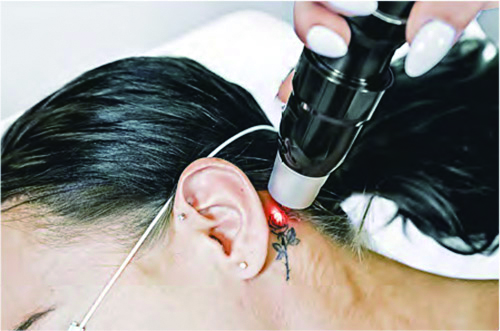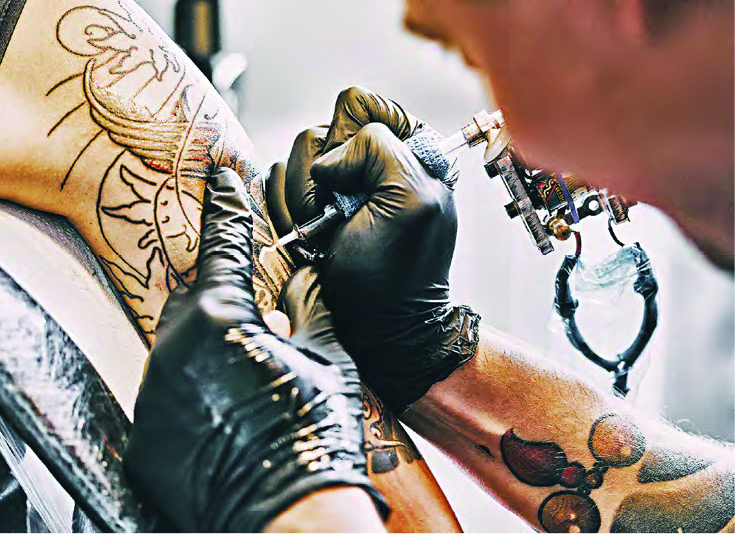Improper treatment of tattoos with bacteria and viruses may lead to hepatitis B and AIDS infection
[ad_1]
Text◆Chen Zhenji “Ming Pao”
Tattoos involve injecting foreign pigments into the skin. Regardless of whether the tattoo ink is natural or contains chemical ingredients, there are health risks.
Dirty tattoo equipment and improper post-tattoo care may cause allergies, bacterial infection, and even infectious diseases such as hepatitis B and AIDS.
(Hong Kong News) Many people regard tattoos as a symbol of fashion, and may leave commemorative patterns or words on their bodies. Some people also choose cosmetic tattoos, such as eyebrow bleaching, eyeliner tattoos, and lip tattoos, to save time on putting on makeup every day.

Redness, swelling and wound healing after two weeks of tattooing
The principle of tattooing is usually to use an instrument (needle) to repeatedly pierce the surface of the skin to create small holes, and then ink is injected into the dermal layer of the skin, leaving a permanent color mark.
Dermatology and venereology doctor Lam Jiawen pointed out that the dermis is the middle layer of the three layers of skin, between the epidermis and subcutaneous tissue. The ink left in the dermis cannot be metabolized, so the tattoo pattern will not disappear. Depending on the degree of puncture and the composition of the ink, some people may experience fading or spreading of their tattoos.
Rose, who has been engaged in tattoo work for 4 years, pointed out that the semi-permanent tattoos commonly referred to in the market are actually eyebrow bleaching, matte eyebrows, etc. that have evolved from cosmetic tattoos such as eyebrow tattoos. They use natural pigments that can be absorbed by the body. The color will fade or discolor over time. , but it won’t disappear completely.
According to the Consumer Council, in the first nine months of 2023, it received 29 complaints about tattoos or cosmetic tattoo services, 80% more than the previous year; 24 of them involved eyebrow tattoos, eyebrow bleaching, lip tattoos, etc., including fever, Reactions such as inflammation, redness, swelling and pain, and in some cases, the cornea was cut during eyeliner tattooing, affecting vision.
Rose pointed out that there will basically be wounds at the tattoo site, and redness, swelling, and scabs will usually appear. The redness and swelling will usually disappear in 1 to 2 days, and the wounds will heal in about two weeks. Larger areas or more complex lines will take longer. “If it persists and doesn’t get better, it could be an infection.”
Allergy to ink can last for years
Lin Jiawen pointed out that there are always risks in getting a tattoo.
“This is an invasive procedure that involves puncturing the skin,
It is possible to introduce bacteria or viruses into the skin and cause infection.”
If infection occurs and is not treated properly, it will leave scars or pigmentation.
If a non-disposable tattoo needle is used during the piercing process,
And it has not been thoroughly cleaned and disinfected. If it has been used on an infected person,
It is possible to spread viruses and bacteria to another person’s body through the blood.
causing blood-borne diseases,
Including hepatitis B, hepatitis C, syphilis, AIDS, etc. “
“Besides this, another more troublesome situation is allergic reaction to ink. Once the ink is injected into the skin, it cannot be easily removed. It will continue to irritate the skin and cause long-term allergic reactions, which can be as short as a few days or as long as several years. “
Lin Jiawen pointed out that the skin will be itchy, rashed, pus discharged, blistered or inflamed, which is relatively difficult to deal with; and allergic reactions may not occur immediately, and may appear days, weeks, or even longer later. You should seek immediate medical attention. In addition to medication, the tattoo may also need to be removed.
Blisters, pigmentation and burns may occur
Nowadays, laser treatment is more commonly used to remove tattoos. The principle is that certain inks can absorb lasers of specific wavelengths. The laser irradiates the skin, splits the ink into smaller molecules through heat energy or vibration, and then is expelled from the body through metabolism.
However, not all inks absorb lasers. Inks of different colors react differently to lasers because each color has a specific absorption wavelength. Generally, red and yellow are difficult to remove, while black, blue, etc. are relatively easy to remove. Generally speaking, tattoo removal requires several sessions, but 100% complete removal cannot be guaranteed.
She also reminded that tattoo removal also comes with risks. The process of absorbing laser light may cause some skin reactions, such as blisters, pigmentation, or burn scars. Pigmentation is the result of an inflammatory reaction in the skin. It does not come from the pigment of the tattoo, but from the pigment produced by the skin cells, leaving a darker mark on the skin.

Pregnancy, diabetes and cardiovascular disease are not suitable
Therefore, you must think carefully before getting a tattoo. Rose pointed out that there are several types of people who are not suitable for tattoos, including those who are pregnant, have diabetes or cardiovascular disease, and have scarred bodies. Lin Jiawen added that it is not recommended for people with skin diseases such as eczema and those under the age of 18. According to the Youth Tattoo Ordinance, it is an offense for anyone to tattoo a person under the age of 18 unless the tattoo is done for medical reasons by a registered doctor.
Eyeliner tattoos may damage the eyeballs and affect vision
As for the location of tattoos, more common cosmetic tattoos such as eyebrow tattoos, eyeliner tattoos, etc. are located on the face and are not blocked, so careful consideration is required.
Lin Jiawen pointed out that eyeliner tattooing is more dangerous because it is close to the eyes. If not done properly, it may damage the eyeballs and even affect vision.
Rose added that areas that are frequently pulled and touched, such as fingers, are more likely to fade and the color will last shorter, requiring frequent touch-ups in the future.


Not suitable if you have skin problems
Do not swim or bask in the sun after getting a tattoo
The tattoo process pierces the skin and injects ink. It is a permanent and invasive procedure. You must carefully choose a professional and hygienic tattoo shop. Pay attention to whether disposable supplies such as gloves and needles are used, whether the tattoo materials meet the specifications, and whether the equipment used before tattooing is thorough. disinfect.
Dr. Lam Jiawen, a specialist in dermatology and venereal diseases, reminds you that you should also pay attention to your own skin condition. If you have any skin problems, you should not get a tattoo.
Apply special tape to prevent wound irritation
Tattoo artist Rose pointed out that after the tattoo is completed, a layer of special tattoo tape is usually applied to prevent the wound from being irritated. It can be removed after a few hours to 3 days, cleaned with warm water or mild soap, and then dried gently with a paper towel.
“You can also apply a thin layer of tattoo repair ointment. Products on the market generally contain natural ingredients such as shea butter and nut seed oil, which can help moisturize and speed up wound healing.”
She recommends filling your stomach before getting a tattoo, because hypoglycemia may cause dizziness or vomiting during the tattooing process.
Keep skin dry and wear loose clothing
Things to note after getting a tattoo:
◆Keep skin dry and clean to prevent infection
◆Avoid swimming, sunbathing, sauna and other activities
◆When the tattoo site is scabbed, it may be itchy. Avoid picking at the wound, otherwise it will affect healing, affect the effect of the tattoo, or lead to infection.
◆If any abnormality occurs, such as pain, discharge, pus, fever, seek medical advice from a dermatologist immediately
◆Wear loose and breathable clothing to avoid friction and irritation of wounds caused by being too close to the body
Source: Dermatology and Venereology Doctor Lam Jiawen, Tattoo Artist Rose

or expand the area Tattoos on scars are risky
Some people leave scars due to injuries and deliberately use tattoos to beautify and cover them.
Dr. Lin Jiawen, a dermatology and venereal disease doctor, reminds that there are certain risks in getting a tattoo on a scar. The scarred skin is not normal skin and is relatively weak. Tattooing may worsen the scar. For example, people with a tendency to have hypertrophic scars have poor scar healing. After getting a tattoo, The scar area may expand or become more unsightly at any time.
Question 1. Does tattoo affect medical procedures?
Answer 1.It is said that tattoo pigment may affect the image clarity of magnetic resonance imaging and positron tomography. Lam Jiawen pointed out that it will only be affected in rare cases.
However, tattooing on moles may mask the symptoms. If there are changes later or there is a risk of cancer, it will be difficult to detect, which may affect the doctor’s diagnosis and delay treatment.
Question 2. Can tattoos cause cancer?
Answer 2.Lam Jiawen pointed out that there is currently no evidence that tattoos will increase the risk of cancer, but many tattoo inks contain carcinogens and heavy metals. According to information from the Consumer Council, overseas studies have pointed out that many tattoo inks contain heavy metals, such as mercury (mercury), lead, copper, nickel, cadmium, arsenic, etc. The types and contents of heavy metals detected in ink of different colors vary, for example Polycyclic aromatic hydrocarbons (PAHs) are more commonly detected in black and dark brown inks, while primary aromatic amines (PAA) are more common in orange and red inks. If you are worried, it is not recommended to get a tattoo.
Question 3. Which part of the tattoo is the most painful?
Answer 3.Tattoo artist Rose pointed out that generally speaking, the pain will be stronger in the neck, ribs, belly, waist, fingers, ears, etc., while the pain in the arms, thighs, etc. will be moderate.
[ad_2]
Source link

![[Love Wants Sex Series 358]Find out the culprit and overcome psychogenic erectile dysfunction…](https://newsworldhealth.com/wp-content/uploads/2023/01/News-World-Health-China.png)

